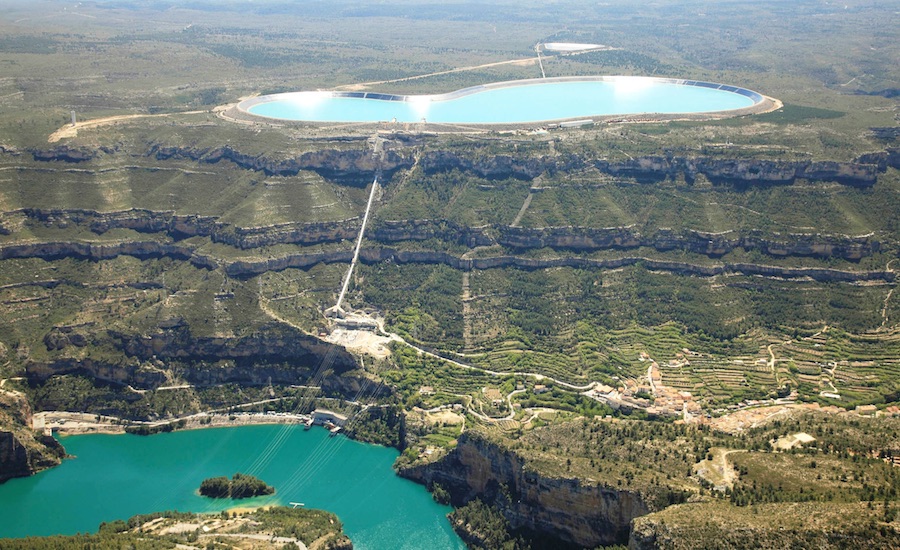GUVNL reserves 16 sites in Gujarat for Pumped Hydro Storage Projects worth 14,210 MW
July 16, 2024
Gandhinagar: The Gujarat Urja Vikas Nigam Limited (GUVNL) had released a list of 16 sites reserved for Pumped Hydro Storage Projects (PHP). These sites will eventually allocated through a competitive bidding process to benefit state public discoms.
The combined potential of these 16 sites is estimated at 14,210 MW, with the highest potential site located in Valsad at Moti Palsan, which has a capacity of 2,400 MW. The second most suitable site is Anjan Kund in Dang, with a capacity of 2,210 MW. Other selected sites are in Valsad, Chhota Udepur, Banaskantha, Narmada, Dahod, and Sabarkantha.
List of 16 sites reserved for Pumped Hydro Storage Projects (PHP)
| Sr. No. | Site Location (village, District) | Project Potential (MW) |
| 1 | Moti palsan, Valsad | 2400 |
| 2 | Anjan Kund, Dang | 2210 |
| 3 | Kaprada, Valsad | 1300 |
| 4 | Wilshon Ghat, Valsad | 1000 |
| 5 | Ganiyabar, Chhota Udepur | 830 |
| 6 | Dharsimel, Chhota Udepur | 730 |
| 7 | Umedpura, Banaskantha | 660 |
| 8 | Turkheda, Chhotaudepur | 480 |
| 9 | Sagbara, Narmada | 240 |
| 10 | Junaraj, Narmada | 340 |
| 11 | Khajuri, Dahod | 280 |
| 12 | Panam, Dahod | 290 |
| 13 | Dobachapura, Chhota udepur | 500 |
| 14 | Abhapur Khervada, Sabarkantha | 200 |
| 15 | Limkhetar, Narmada (NWDT) | 1500 |
| 16 | Vanazi, Narmada (NWDT) | 1250 |
| Total Potential Capacity (MW) | 14210 |
What is Pumped Hydro Storage?
Pumped storage hydropower (PSH) is a form of hydroelectric energy storage that utilizes two water reservoirs at different elevations. During periods of excess electricity, such as off-peak hours or from renewable sources like solar and wind, surplus power is used to pump water from the lower reservoir to the upper reservoir.
However, when electricity demand rises, the stored water is released from the upper reservoir back to the lower reservoir, flowing through turbines that produce electricity. This system functions like a large battery, storing energy and releasing it when required.
PSH can be classified as either open-loop or closed-loop. Open-loop pumped storage hydropower systems link a reservoir to a naturally flowing water source through a tunnel, utilizing a turbine/pump and generator/motor to transfer water and generate electricity. Closed-loop pumped storage hydropower systems, on the other hand, connect two reservoirs without natural water flow, also using a tunnel, turbine/pump, and generator/motor for water movement and electricity production.

Central Government’s Focus on Pumped Storage Projects (PSP)
GUVNL’s actions align with the Indian government and state utilities’ increased focus on energy storage solutions, including battery energy storage and pumped hydro storage projects. The Government of India’s Ministry of Power has issued Guidelines to Promote the Development of Pump Storage Projects. As per those guidelines among the various technologies available for storage and ancillary services, Pumped Storage Projects (PSPs) are clean, MW scale, domestically available, time-tested, and internationally accepted.
India is progressing towards a clean energy transition, aiming to meet Nationally Determined Contribution (NDC) targets. These targets include reducing the emission intensity of its Gross Domestic Product (GDP) by 45% by 2030, achieving 50% of installed capacity from non-fossil fuel sources by 2030, and reaching net-zero carbon emissions by 2070. Developing PSPs is crucial for providing greater inertia and balancing power to the grid.
The Central Electricity Authority (CEA) estimates that the country will require 26.7 GW of PSPs and 47.2 GW of battery energy storage (5 hours) to integrate the anticipated renewable energy capacity by 2032. If the cost of battery energy storage systems (BESS) does not decrease as expected, the PSP capacity requirement may increase. DeshGujarat
Recent Stories
- GreenLine invests $275m in Green Logistics; Nikhil Kamath invests $20m
- Vantara announces launch of new website
- Lion census in Gujarat from May 10–13; AI to assist in process
- Survey begins for 6-lane expansion of Bilimora–Chikhli–Vansda–Vaghai Highway
- Atal Ashram in Surat prepares giant 6000kg laddu for Hanuman Jayanti
- RSS Chief Mohan Bhagwat to visit Gujarat on April 12
- Academic Calendar 2025–26 for schools in Gujarat announced

